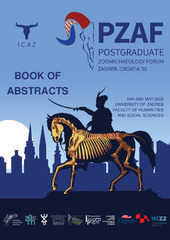Приказ основних података о документу
The Late Antique dietary habits in Western Serbia: a case study of the Čačak – Dvorište Gimnazije site
| dc.creator | Mladenović, Mladen | |
| dc.creator | Mladenović, Teodora | |
| dc.creator | Dmitrović, Katarina | |
| dc.date.accessioned | 2023-10-19T13:58:17Z | |
| dc.date.available | 2023-10-19T13:58:17Z | |
| dc.date.issued | 2023 | |
| dc.identifier.uri | http://reff.f.bg.ac.rs/handle/123456789/5019 | |
| dc.description.abstract | The analysed faunal material was collected during the rescue archaeological campaigns conducted between 2014 and 2018 by the National Museum Čačak at the Dvorište Gimnazije site in Čačak (Western Serbia). The Late Antique building remains, constructed in the 3rd–4th century, preserved at the foundation level were discovered at the site. After its destruction, the building was reused during the late 4th and the 5th century but in a more primitive manner. Remains of a few pits, hearths, and probably primitive dwellings belong to this horizon. The 3rd horizon at this site dates to the Late Medieval period (the 15th and the first half of the 16th century), and it is represented by a Christian necropolis dug into the Roman building. Faunal material is more abundant in the Late Antique period than in the Late Medieval context. The remains of mammals form the majority of the faunal sample. Domestic species are more frequent within the assemblage and include cattle, pigs, sheep and goats, horses, dogs, and cats. Furthermore, wild species are represented by wild boar, red deer, roe deer, fox, and hare. The most common are the remains of cattle, followed by pigs and caprines. Among wild mammals, the most numerous remains belong to wild boar and red deer. The greater importance of domestic mammals is expected for the Late Antique and Medieval archaeological sites in Serbia. In addition, the bird remains were confirmed as well. Among them, the remains of chicken were the most numerous. Since this is a newly discovered site, additional archaeological excavations in the vicinity are needed to create a broader picture of this site and its role within the currently unnamed ancient settlement that lasted throughout the centuries by the Western Morava River. Moreover, new zooarchaeological research will enable a better understanding of human–animal relationships of the inhabitants of this settlement in the past. | sr |
| dc.language.iso | en | sr |
| dc.publisher | Department of Archaeology, University of Zagreb Faculty of Humanities and Social Sciences | sr |
| dc.publisher | Institute of Archaeology, Zagreb | sr |
| dc.relation | info:eu-repo/grantAgreement/ScienceFundRS/Ideje/7750265/RS// | sr |
| dc.rights | openAccess | sr |
| dc.rights.uri | https://creativecommons.org/licenses/by/4.0/ | |
| dc.source | 10th PZAF (Postgraduate ZooArchaeology Forum), Zagreb, Croatia, 24–26th May | sr |
| dc.subject | faunal material | sr |
| dc.subject | Čačak – Dvorište Gimnazije | sr |
| dc.subject | Late Antique | sr |
| dc.subject | Late Medieval periods | sr |
| dc.title | The Late Antique dietary habits in Western Serbia: a case study of the Čačak – Dvorište Gimnazije site | sr |
| dc.type | conferenceObject | sr |
| dc.rights.license | BY | sr |
| dc.citation.rank | M34 | |
| dc.citation.spage | 16 | |
| dc.identifier.fulltext | http://reff.f.bg.ac.rs/bitstream/id/12266/bitstream_12266.pdf | |
| dc.identifier.rcub | https://hdl.handle.net/21.15107/rcub_reff_5019 | |
| dc.type.version | publishedVersion | sr |

